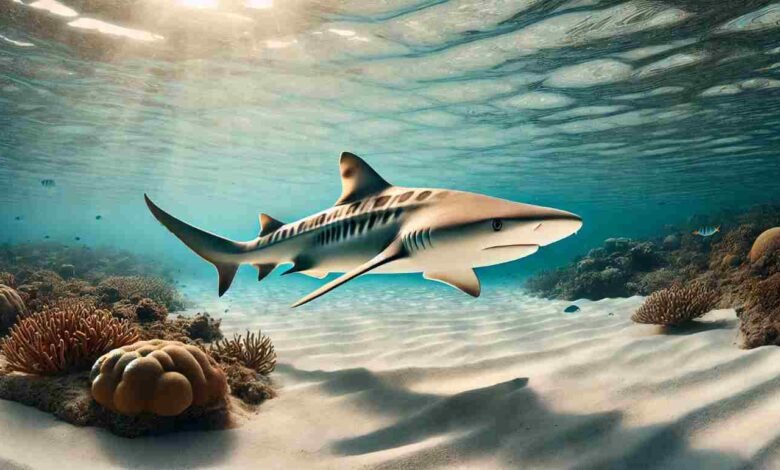Bamboo Shark: Size, Habitats, and Facts

Bamboo shark is a unique species found mainly in the Indo-Pacific region, captivating marine enthusiasts with their fascinating behavior and small size. Despite their menacing title as “sharks,” these creatures are generally harmless and have become popular inhabitants of home aquariums. Let’s dive into the world of bamboo sharks, exploring their size, habitats, and interesting facts about their lives.
What is a Bamboo Shark?
Bamboo sharks hail from the family Hemiscylliidae and occasionally one may hear them being called longtail carpet sharks, on account of their elongated streamlined bodies. Bamboo sharks include many species as shown in the picture above – brownbanded (Chiloscyllium punctatum) and whitespotted bamboo shark, etc. They may come in different colors and patterns but most of them physically and behaviorally adapted for life by the salty shores on which they dwell.
Size and Physical Appearance
Unlike other species, bamboo sharks are small. The various species of bamboo sharks only reach between 2 to 3 feet, with the brownbanded able to grow up to 4 feet in length under optimal conditions. These long-bodied creatures have a brief tail and can slide effortlessly through thick layers of coral reef and sea cucumbers.
They have dark bands or spots on their backs, setting them apart in terms of markings. The whitespotted bamboo shark can be easily identified by its white spots against a light-colored body, whereas the brownbanded bamboo shark shows dark brown bands that run horizontally along their otherwise lighter-shaded bodies.
In terms of size and structure, bamboo sharks are built for bottom-dwelling environments. Their large, broad heads, wider than long, feature a small slit-like mouth at the front, enabling them to use suction to feed on prey living near the substrate. Moreover, this body form aids in camouflage, allowing them to hide in their surroundings. These habits are rare among larger shark species, and their long pectoral fins enable them to “walk” across the ocean floor.
Habitat and Distribution
Bamboo sharks are mostly found in the Indo-Pacific region, within warm and shallow waters. These sharks mostly live around coral reefs or rocks like on the coasts of Indonesia and Malaysia to Japan, India including some islands in the Philippines.
In the context of hiding and food availability, they like these habitats very much. When compared to other species of sharks, bamboo enjoys warmer waters at 75 to 82°F (24-28°C) again due to local environmental conditions. They are nocturnal in nature and move about at night scouring for small fish, crustaceans, and mollusks. They spend the day hiding in cracks, holes, or corals where they can save energy and avoid predation.
Bamboo sharks are also typically benthic, or they live near the bottom. They use their camouflage and rock hoppers to escape larger predators, as well as to surprise a potential meal. Although most are not endangered, they can have an unhealthy relationship to their environment, and we disrupt it at our peril.
Diet and Feeding Habits
Bamboo sharks are nocturnal hunters and usually prefer to eat smaller sea life located at the bottom of oceans. Their basic diet includes smaller fishes, shrimps and crabs, not forgetting a lot of mollusks. A specialized modification they employ to track down their food is the use of electroreceptors situated on the snout that can sense feeble electrical signals produced by buried prey. Both their small, yet sharp teeth have the ability to grip or crush whatever they are lucky enough to find.
Bamboo sharks have a unique set of backward-pivoting teeth for crushing hard-shelled prey such as crabs and clams. Their biology allows them to be highly efficient predators that rely on this feeding adaptation within the food web of their environment. Due to their small size and selective prey, they are not a great threat to other marine species, but such jellyfish could be crucial in maintaining the equilibrium of marine life within its habitats.

Behaviour and Reproduction
Bamboo sharks are rather apathetic, sluggish creatures. They are for the most part nocturnal bottom dwellers or slow slippers among rocks and reefs. Because they are bottom dwelling fish, bamboo sharks evolved with a more sedentary lifestyle than faster open-water species. Their “walking” is done using their pectoral fins, which are extended out to enable them to step around on the ocean floor and look for food while they meander in shallower waters.
Bamboo sharks are oviparous, which means that the female lays eggs instead of giving live birth. The embryos develop inside egg cases, or “mermaid’s purses,” for about 14-15 weeks before they hatch, ready to start feeding on various smaller animals living in shallow coastal waters.
These egg cases are frequently attached to the bottom, sheltering the embryonic shark until it emerges. Even more interesting, with two bamboo shark species, the whitespotted and brownbanded types, instances of parthenogenesis (where a female can produce offspring without being fertilized) have been documented.
Bamboo Sharks in Aquariums
Technically, bamboo sharks become popular species in both public and private aquariums since they are small-ish size as well calm. They need the right environment, large tanks with lots of hiding spaces and specific substrates to replicate their natural habitat. When kept in captivity, a bamboo shark can live up to 25 years if provided with the right conditions (their lifespan may be shorter in the wild due to predation and disease).
Conservation and Threats
Like all marine life, bamboo sharks are facing difficult obstacles from humans. The habits of some species have been heavily fished, and lost both habitat destruction or the need for aquarium trade sharks familiarize with a decrease in their population (2008). Not all species are endangered at present, but several like the whitespotted bamboo shark is listed as “Near Threatened” by IUCN (International Union for Conservation of Nature). Conservation is very important for preventing bamboo sharks from disappearing in the wild.
The Bottom Line
Bamboo sharks are interesting due to several unique adaptations that allow them to easily live in shallower waters of Indo Pacific. From their long spindly bodies, to the band of white around it neck and even its interesting nocturnal hunting behavior, they each give us a lens into some aspect of life under that ocean blue. Even though it is considered a smaller species of shark, the bamboo sharks have an important role in keeping the oceans ecosystems balanced and that conservation efforts are crucial for healthy seas.





